Affiliate disclosure: This post may contain affiliate links. Please see our Privacy Policy.
Tansy (Tanacetum vulgare) is a medicinal and culinary herb with a long history of practical use. Modern medical science confirms many of these centuries-old uses but also adds some cautions for use. It’s a fun find in the wild, but definitely one to use with caution.
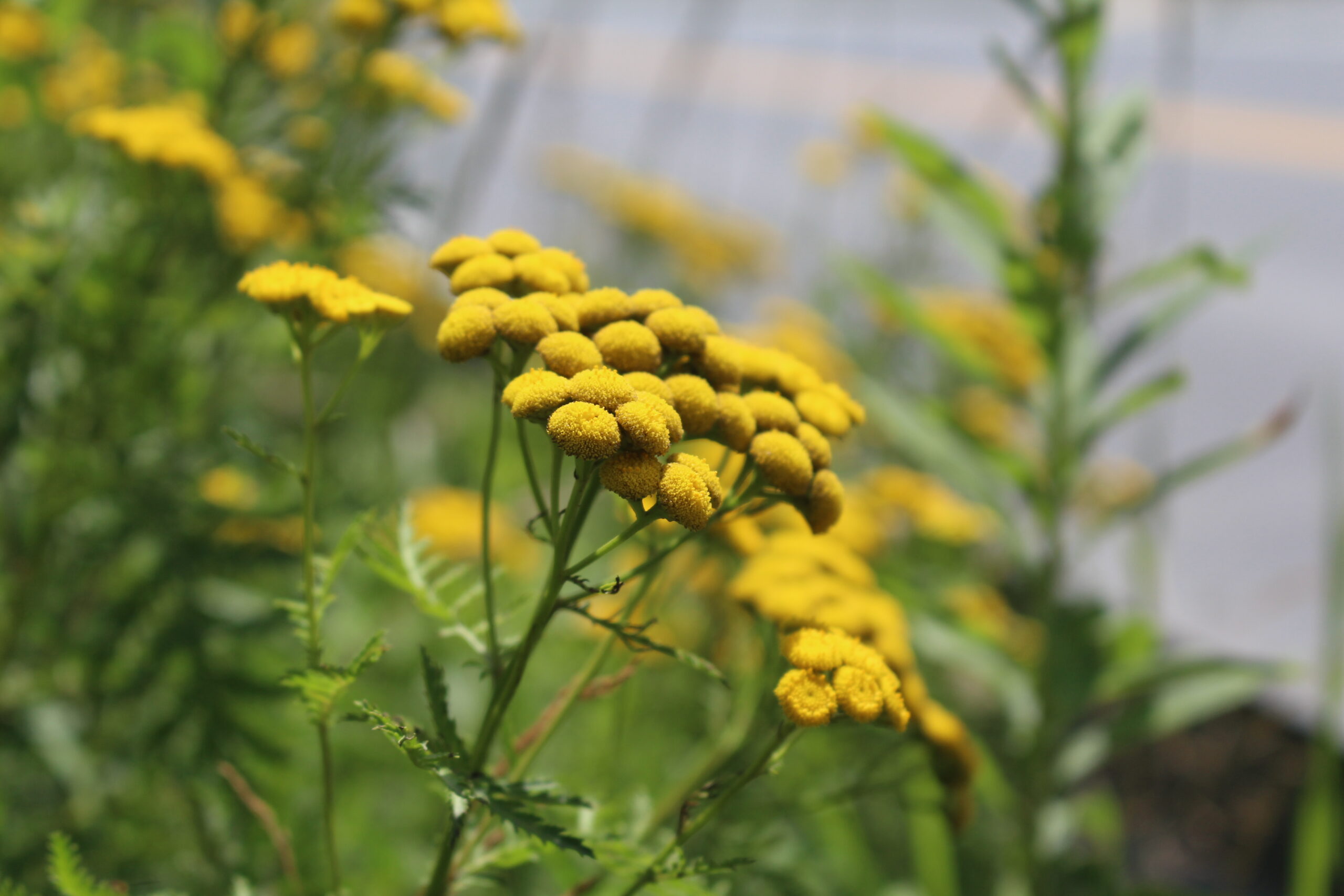
Tansy was commonly grown in the Middle Ages (and well before) in monastery gardens and kitchen herb gardens all over Europe. It was used for seasoning, but more commonly, for preservation and pest control.
Meat would be packed in tansy to prevent spoilage, and they’d use tansy to keep pests, insects, and rodents at bay.
They even packed bodies in tansy to keep them a bit longer if the funeral was going to be delayed for any reason.
Be aware that modern medicine cautions use of tansy, beyond in small amounts. It does have some compounds that can be problematic in humans, except in low doses.
Historically, and even in recent times, it was used to “bring the menses” so it should be avoided by pregnant and breastfeeding women as well.
These days, you can find tansy growing wild just about anywhere. The seeds spread easily, and it’s just as at home in the garden as it is on a highway roadside.
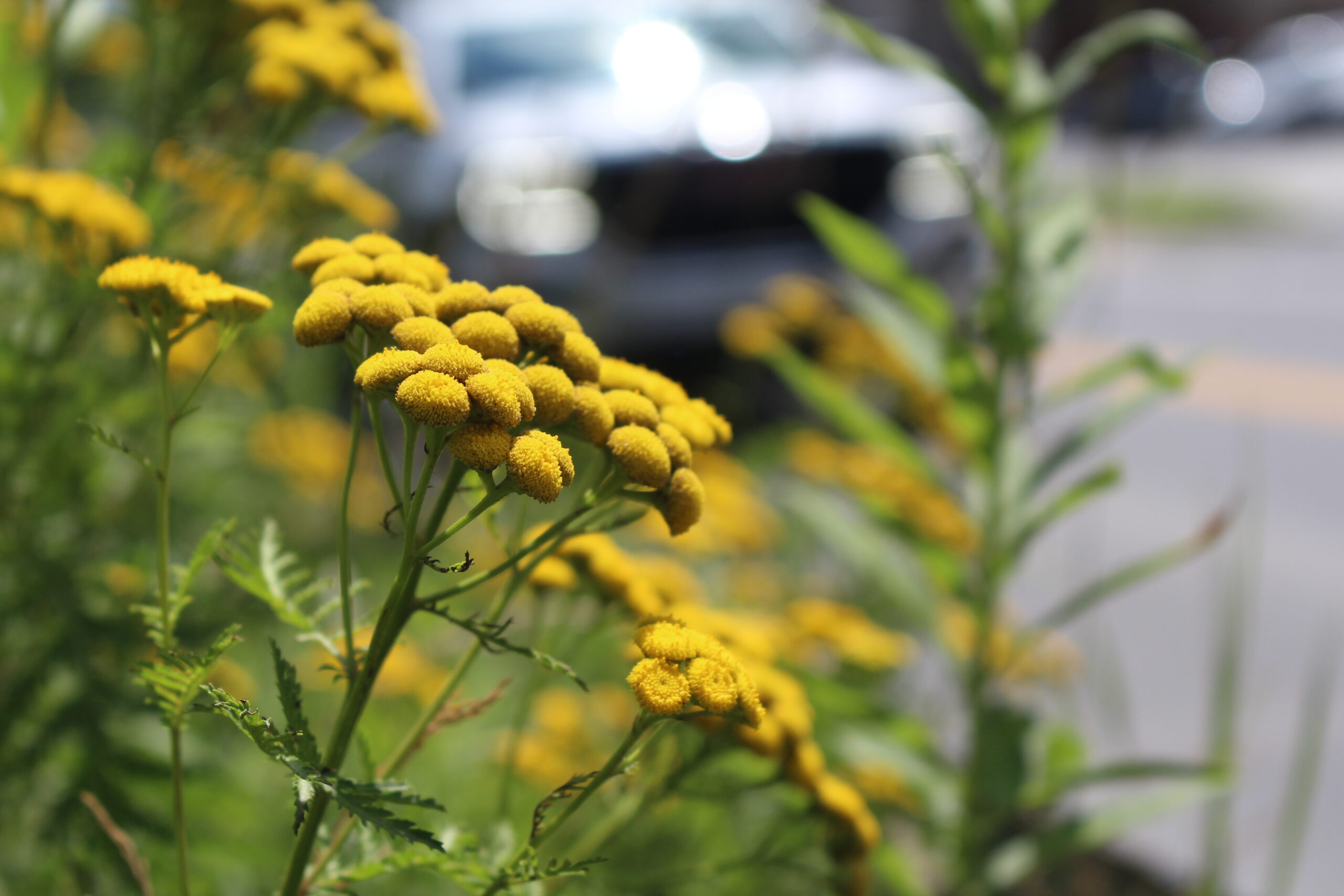
What is Tansy?
Tansy or Tanacetum vulgare is a perennial, herbaceous weed in the Aster or Asteraceae family. You may also hear it called Common Tansy, Garden Tansy, Stinking Willie, Cow Bitter, Bitter Buttons, or Golden Buttons.
Tansy is native to temperate parts of Europe and Asia but has been widely spread through the world’s temperate regions. It’s an invasive weed throughout much of North America.
Is Tansy Edible?
Tansy is edible, though it is frequently used in small amounts for flavoring rather than as a potherb or fresh green. Herbalists have also used Tansy for thousands of years, both in internal and external preparations. Typically, people use the leaves and flowering stems.
Externally, Tansy may cause contact dermatitis in some individuals. Tansy also contains a compound called thujone, which is toxic to humans. While small doses may be safe, large quantities of Tansy or concentrated preparations such as essential oil can be dangerous. An overdose of Tansy can cause diarrhea, vomiting, seizures, dizziness, kidney or liver damage, or even death.
Historically, herbalists have used Tansy as an abortifacient to terminate pregnancies. Women who are pregnant or nursing should avoid consuming Tansy.
Some sources report that Tansy may be toxic to some grazing livestock. Thankfully, most animals seem to ignore Tansy due to its strong odor.
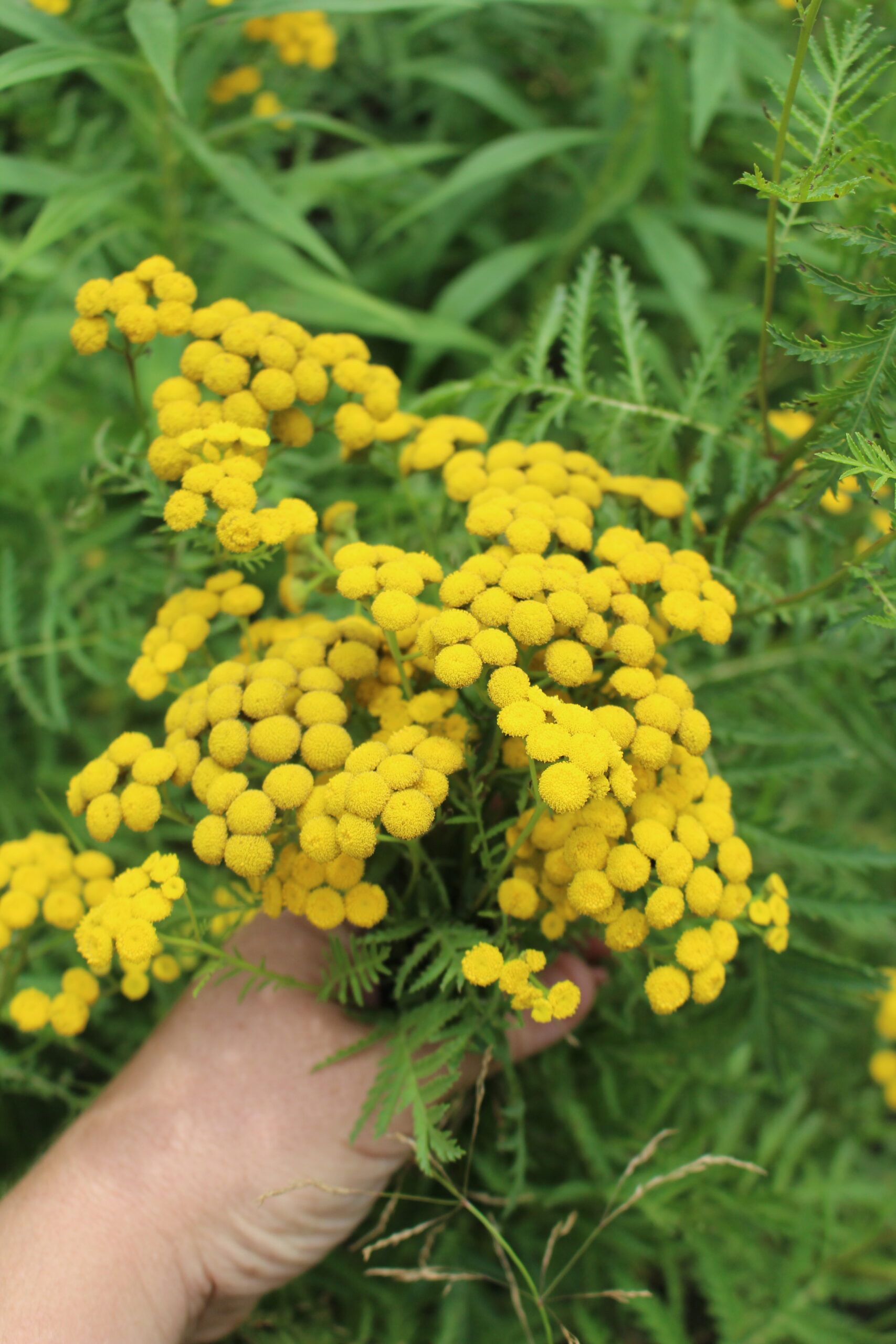
Tansy Medicinal Benefits
Tansy is one of those herbs that has seen centuries of use in herbal medicine. Our first records of the plant’s use come from ancient Greece, where the name “tansy” meant immortality. In Greek mythology, Ganymede was made immortal by drinking tansy juice.
In the 8th century, Charlemagne (Charles the Great) grew Tansy in his famous herb gardens. Benedictine Monks were also growing the herb in the garden of the Swiss Monastery Saint Gall. During this early period, herbalists used Tansy to treat rheumatism, digestive problems, sores, fevers, intestinal worms, and measles.
During the Middle Ages, women used Tansy. They took small doses to help conceive children and prevent miscarriages, and large doses to induce abortion. Sometimes therapeutic uses, even opposite ones, are all about dosage.
In the 15th century, Christians began incorporating the bitter Tansy into their Lenten meals. This had multiple purposes. It commemorated the bitter herbs eaten by the Israelites during Passover, helped relieve flatulence caused by eating fish and pulses, and prevented intestinal worms they believed may have come from the fish consumed at Lent.
Native Americans also began incorporating Tansy into their medicinal practices when Europeans introduced it to North America. Probably, they were already familiar with the plant’s native relatives like Camphor Tansy (Tanacetum camphoratum). The Cherokee made Tansy infusions for treating backaches and as an herbal tonic. They also wore wreaths of the plant around their waists to prevent miscarriages. The Cheyenne also used a Tansy infusion, made from the crushed leaves and flowers, that they used to treat dizziness and weakness.
Herbalists have also used Tansy externally and historically believed it would lighten and purify the skin. According to Irish folklore from the 19th century, a bath of Tansy and salts would cure joint pain.

Throughout history, people have also used Tansy as a preservative agent in food and the treatment of human remains. During the American Colonial period, people packed or rubbed meat with Tansy to repel pests and delay spoilage. They also used it to pack coffins and wrapped it in funeral shrouds.
Modern research has supported Tansy’s use as a preservative. A study exploring the antibacterial and antioxidant activity of Tansy essential oil and extract found that Tansy had a high antioxidant potential. Researchers felt that the plant might be a good choice for products for the pharmaceutical and food industry as an antiseptic and preservative agent.
Modern science also supports Tansy’s historic use as a treatment for worms and other intestinal parasites. In 2013, researchers looked at treating Schistosomiasis, a prevalent disease caused by trematode flatworms that affects more than 200 million people worldwide, with Tansy. They found that a combination of Tansy essential oil and extract at 200 μg/mL caused 100% mortality in all adult worms and reduced the viability and production of developed eggs.
A further review of Tansy’s biological properties found that it has many helpful actions. Tansy was shown to have antibacterial activity against gram-negative bacteria, wound-healing and anti-inflammatory activities, cytotoxic activity against cancer cells, antifungal activity, and antioxidant activity. These findings further support Tansy’s role in traditional medicine.
Where to Find Tansy
Native to the temperate regions of Asia and Europe, Tansy has traveled worldwide with humans as a horticultural, culinary, and medicinal plant. Today, it grows in many temperate regions, including North America.
Tansy is a weedy plant, and you’re likely to find it growing along roadsides, hedgerows, and in waste places, gravel pits, and pastures. Tansy prefers areas that receive full sun and have well-drained soil but will tolerate various soil types, including clay, loam, or sand with acidic, neutral, or alkaline pH.
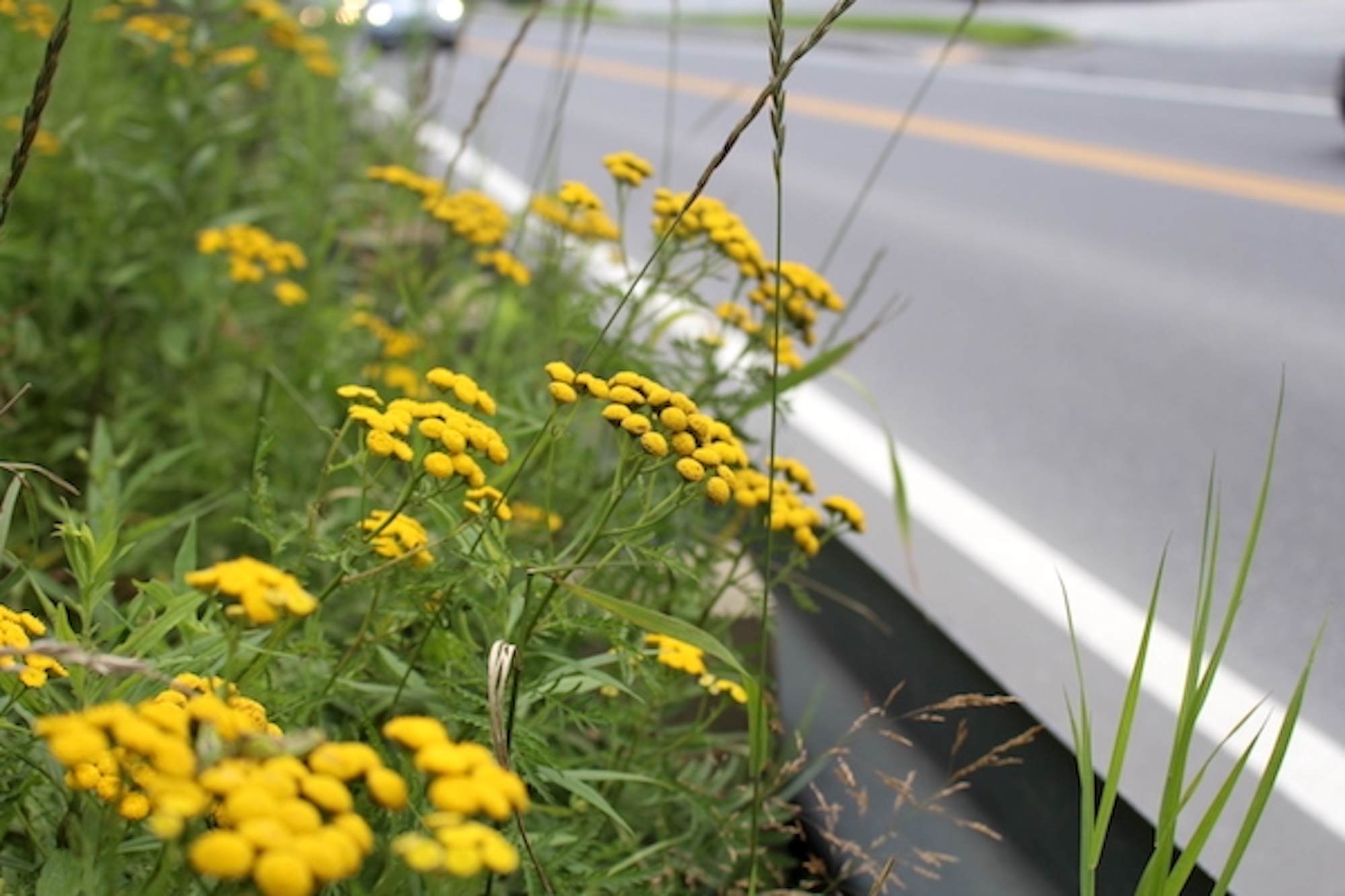
When to Find Tansy
Tansy is a hardy perennial, but the plant’s above-ground parts die back completely in late fall or early winter. However, you may still spot the brown stems and seed heads, which often persist through the winter.
The plants begin with feathery fern-like leaves in the spring before sending up their flower stems during the summer. Many herbalists prefer to harvest Tansy while it is in bloom. Tansy typically flowers in late summer or early fall between July and September.
Identifying Tansy
Tansy has a fairly distinct appearance and is generally pretty easy to pick out. Look for its fern-like leaves and tall flowering stems with yellow button flowers. The flowers often look a bit like all the petals have fallen off of an ox-eye daisy, and they grow in a flat-topped cluster.
Tansy spreads through its lightweight seeds, often transported by wind, water, or farming equipment, and through underground rhizomes. As it spreads rhizomatously, it’s not uncommon to find Tansy growing in large patches or colonies. The colonies grow densely and often choke out native vegetation.
Tansy Leaves
Tansy has green, alternately arranged, pinnately compound leaves with a feathery, fern-like appearance. The leaves are divided almost to the center into about seven segments or lobes, each of which is divided into smaller lobes with saw-toothed edges.
The leaves are typically 3.9 to 5.9 inches long, generally become smaller towards the top of the flower stalk, and are fragrant when crushed.
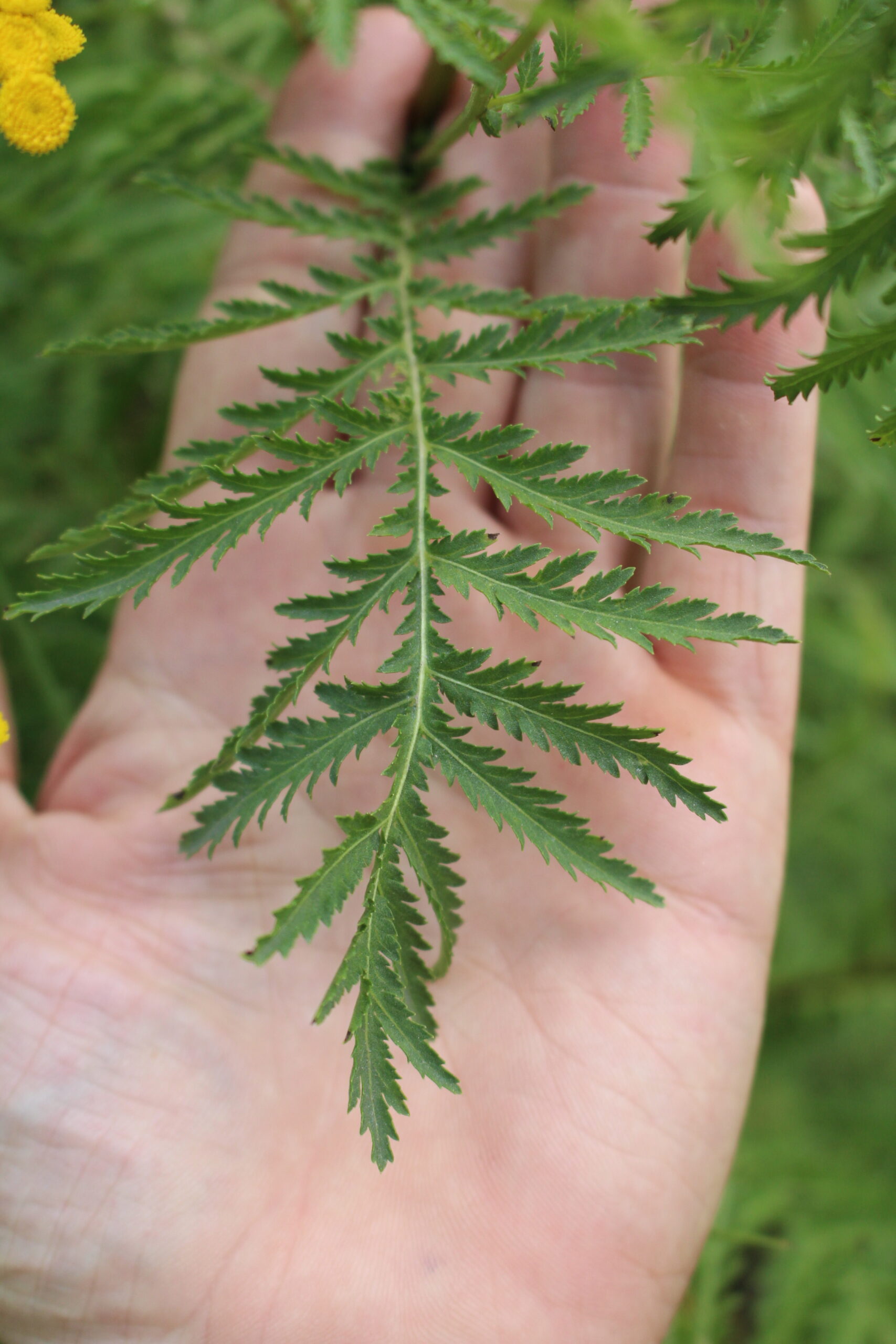
Tansy Stems
Multiple Tansy stems grow from a single clump, giving the plant a shrubby appearance. The stems are reddish-brown and typically grow 3 to 4 feet tall, though they occasionally reach up to 6 feet tall.
The stems are typically woody, slightly hairy, dotted with glands, and unbranched until the flower head.
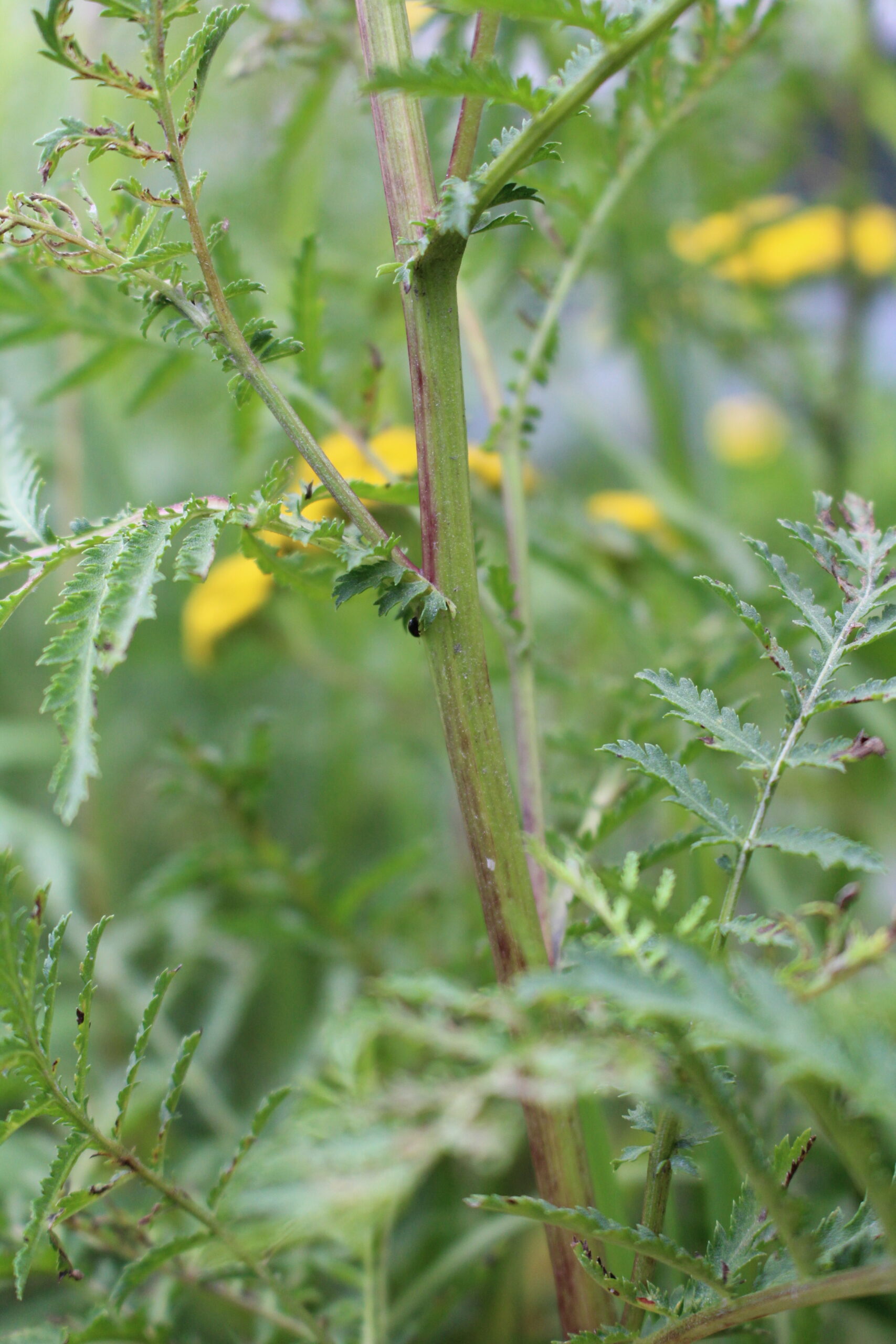
Tansy Flowers
Tansy flowers grow in dense, flat-topped clusters on the tips of the stems, usually between July and September.
The flowers are bright yellow, round, and button-like.
Each flower is usually about ¼ to ½ inch in diameter.
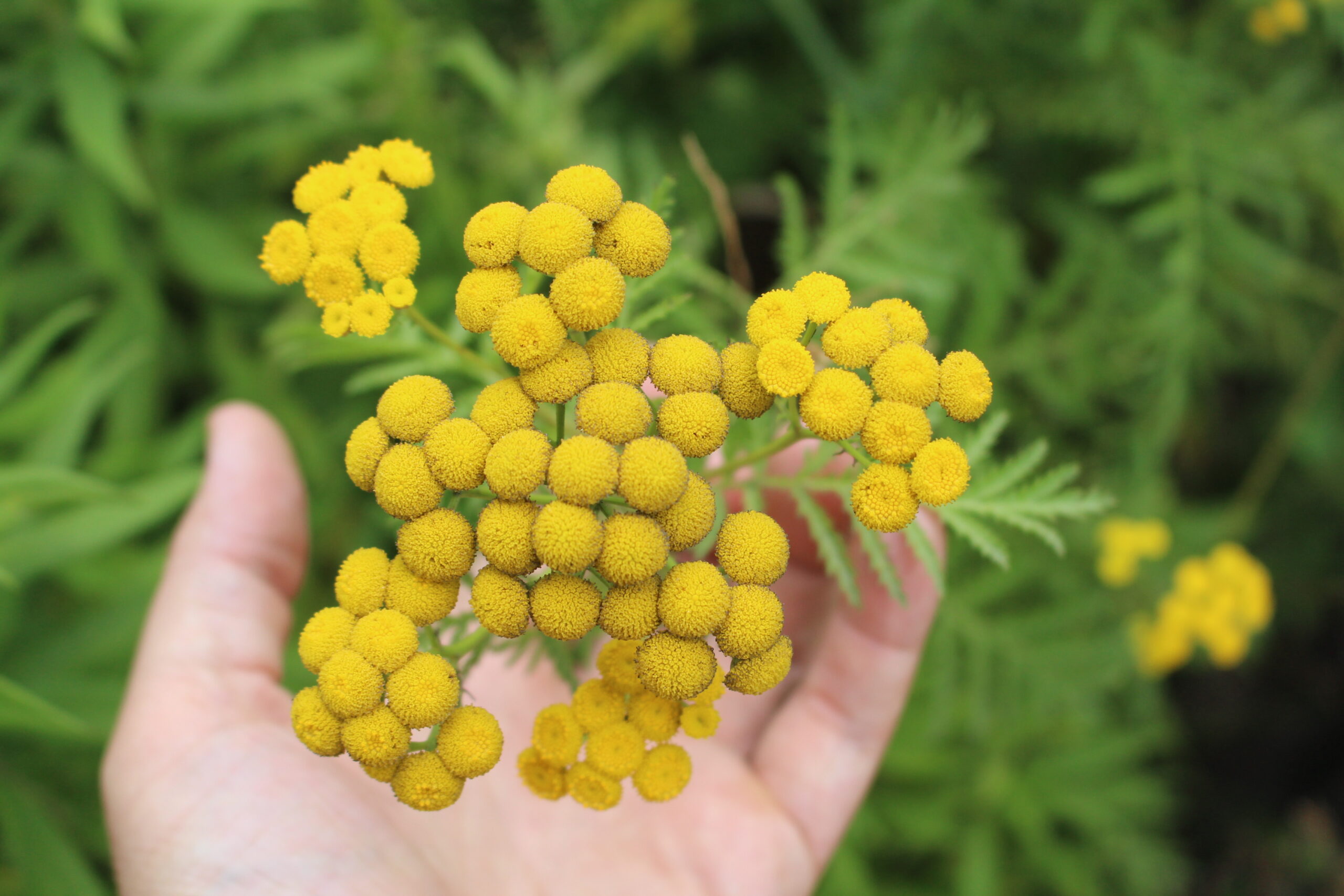
Tansy Seeds
Tansy has tiny brown seeds, generally just 1 to 2 millimeters wide, that have ribs and are dotted with glands. Each seed is attached to a crown-shaped pappus, a parachute-like structure similar to dandelion seeds, that allows them to wind disperse.
The seeds typically ripen between August and October, but the seed heads generally persist on the plants all winter.
Tansy Look-Alikes
Tansy can be mistaken for Common Groundsel (Senecio vulgaris). Thankfully, there are a few simple ways to tell them apart:
- Common Groundsel only grows to about 16 inches tall.
- Common Groundsel leaves are pinnately lobed and sparsely covered with soft, smooth, fine hairs.
- Common Groundsel flowers look a bit like small, drooping dandelion flowers that never open.
Tansy is also sometimes confused with St. John’s Wort (Hypericum perforatum). However, it differs in two easy-to-spot ways:
- St. John’s Wort has oppositely arranged, narrow, lance-shaped leaves that grow 1 to 2 inches long.
- St. John’s Wort has showy, star-shaped flowers with five petals that have black dots at the margins.
Lastly, Tansy can be confused with Tansy Ragwort (Jacobaea vulgaris, syn. Senecio jacobaea). However, it can be distinguished in the following ways:
- Tansy Ragwort leaves are green on top and whitish below with deep, blunt-toothed lobes that give them a ruffled appearance.
- Tansy Ragwort has daisy-like flowers that usually have 13 petals.
Ways to Use Tansy
The cheerful-looking Tansy is a fun herb to forage because, as a noxious invasive weed, you don’t have to worry about over-harvesting. However, Tansy should be consumed in small quantities, so it’s generally best to use it as a spice in culinary creations as a spice.
Historically, Tansy was a popular herb for the common folk who couldn’t afford other spices, particularly in Britain. They used Tansy to flavor both sweet and savory creations. Experiment with chopping up a few sprigs of Tansy for flavoring meats, stuffing, cakes, custards, salads, and egg dishes. You can also dry a few sprigs for later use.
Many folks have also enjoyed using a bit of Tansy to flavor beer, wine, and cocktails. Reportedly, Jack Daniel liked his whiskey served best with a spring of Tansy! Part of this use may stem from the fact that Tansy contains the toxic compound thujone, the same compound found in Wormwood, the traditional herb for making absinthe.
Tansy should be used medicinally with extreme caution, forethought, and research. You can use the leaves, flowers, and flowering stems of Tansy in internal and external medicinal preparations. However, as Tansy contains toxic compounds, it’s generally best to use the plant in infusions and washes for external use.
Tansy also has several non-medicinal and non-culinary uses. Tansy’s golden button flowers make a wonderful natural dye.
It also has been historically used as a pest repellent. In ancient times, the whole plant was used, but during the 1940s, Tansy was commonly grown and harvested for use in bug spray before the advent of DEET.
Its pest-repelling properties also lend it to use in the garden. Tansy is an excellent companion plant. One study even found that it reduced Colorado Potato Beetle populations by 60% to 100%. It’s also thought to work against squash bugs, cucumber beetles, Japanese beetles, and ants. Additionally, some beekeepers use the herb in their smokers.
Tansy Recipes
- For a new twist on a traditional recipe, check out Eatweed’s Tansy Pancake recipe inspired by a recipe published in The New Art of Cooking by Richard Briggs in 1788.
- Turn your fragrant Tansy sprigs into a sweet treat with this recipe for Rose and Almond Tansy pudding with Butternut Squash Ice Cream from The Great British Chefs.
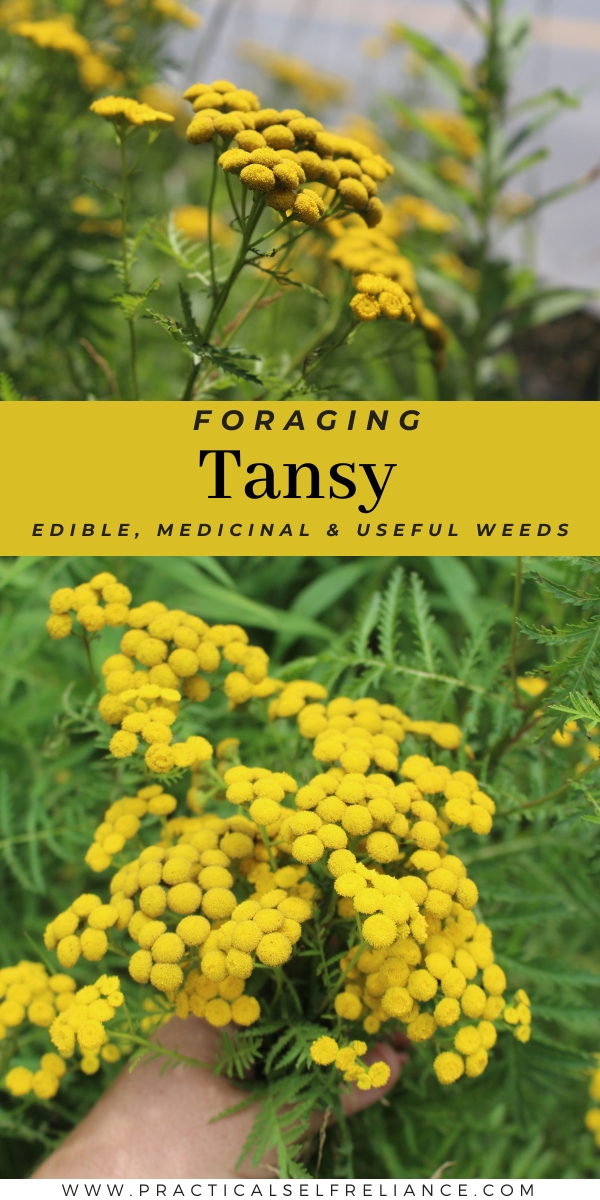

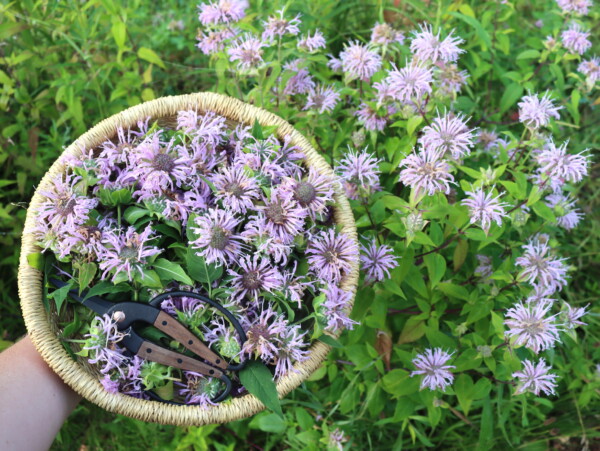
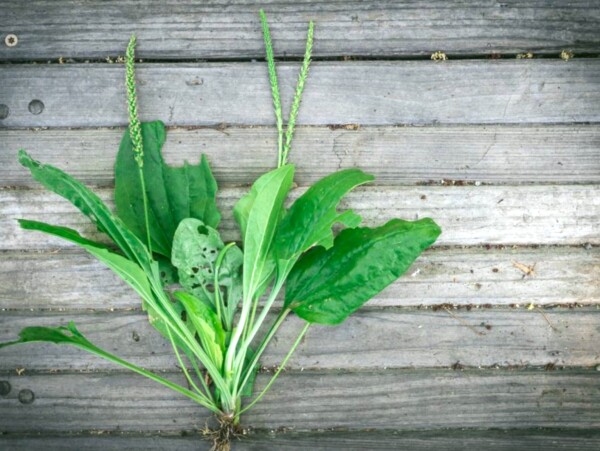
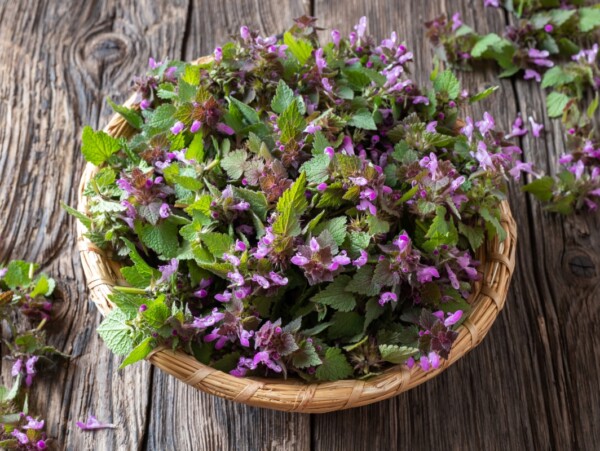










I use dried and shredded tansy to repel pests. I fill small muslin bags and tuck them in each drawer and hang them in closets. Clothes keep fresh and insects/rodents are kept at bay.
Sounds like an excellent idea!
Thank you, Ashley! I’ve had Yellow Tansy in my yard for about 10 years. I typically would only use it by grabbing some leaves to help me scrub some of my neglected compost pots before I dump them into my bigger composter (everything else seems to be a priority over compost dumping) The Tansy leaves help scrub as well as dispel bad odors and then it all gets dumped in the Big One!
I have always been amazed at your generosity to share the wealth of detail freely. I often find just what I need when I need it because you time your presentations with what’s happening now. I absolutely love that you have already made me regret that I pulled out and threw away my henbit and deadnettle last year, as they were increasing in their space…now I understand better what to do with them. I love the order, and ease of use, beauty, and great pics that pull me in. Thank you thank you for this one-stop treasure.
Thank you Patricia! In my house, dumping that compost bucket always ends up on the back burner too for some reason. Just the way it is. Glad you’re enjoying the site!